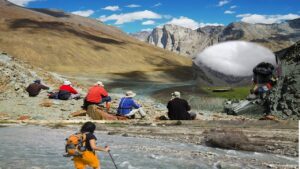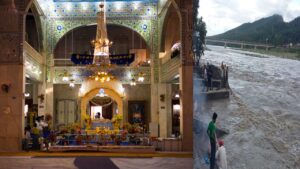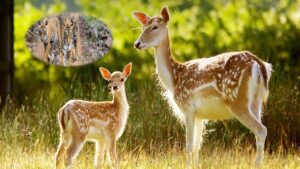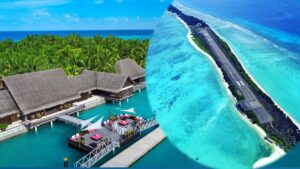Trekking In India- Daily Itinerary ,Packing Tips,Do’s, Dont’s
Trekking In India : A Must-do experience to any serious traveler!
Here is a brief introduction of places which are famous for Trekking In India:
Chadar Trek (Zanskar)- A FROZEN RIVER TREK
Have you ever dreamt of walking through frigid climate and spellbinding panorama? Do your blood flow doubles when you think of unusual and adventurous trekking? If yes, then one of the most thrilling treks across the blue planet, Chadar Trek is the place for you.
Chadar trek is located in Leh, Ladakh in the Indian state of Jammu and Kashmir, the trek is over Zanskar river which freezes in winter when the temperature drops to -300C to -350C, the erstwhile Chadar trek was a seasonal migration route undertaken by Chanpa, Dardic and Mon people. But with the passage of time and explore this route became itinanerary attraction and hardy locals now working as guides and porters to navigate trekkers and tourists through a hostile alien environment.
Best time to visit the place is January to February, during this time ice is in the most stable state with no water holes or thin ice sheets at all.
STARTING POINT
The only way to reach Zanskar is through the flight. The nearest airport is in Leh and all flights land before noon, from here you can head to Chilling (64 km) by road and then trek for about 2 hours to Tilat Sumdo, the starting point.
THE JOURNEY OF LIFETIME
Tilat Sumdo is the campsite for the trek. It is the merger of Zanskar and a small stream, where the trek starts. Onwards there is Shingra Koma, which is almost 10 km from Sumdo. After Koma, there is an eye catching spot of the Chadar trek — Tibb, a place crowded with caves and waterfalls. The caves are used for night stays while waterfalls nurture the viewers sight by the most scenic vistas of the Himalayas in Zanskar valley. Nerak follows Tibb and next comes another campsite called Gyalpo, a bend in the river, a beautiful place full of walls of rocks resembling human faces. Illusory is the word to explain the sights here. The trek further goes through Dibyok ma and ends at Ling shed which is among the oldest villages in Ladakh.
DO’S
- Don’t lose heart Maintain that adrenaline rush for a good period of time. Don’t lose heart as good things come to those who try.
- Follow the locals, they know the best of the trek so follow them strictly!
- Carry sufficient food and water, food supplies may fall short.
- Keep a handy first aid kit as the cuts and bruises is a a welcome greeting here.
DONT’S
- Do not ignore the Guide. Follow him/her conscientiously.
- Do not litter, keep your surroundings clean.
- Do not over stress. Take a break when you feel it is required.
The trek is undoubtedly not easy, but if you are a passionate explorer, and take certain caution then this a must-do once in a life-time experience. The fame associated with this trek can be gauged by the fact that films have been made on the Chadar Trek by the coveted National Geographic and Discovery Channels.
Trekking Mt Kanchenjunga
Have you ever heard of Mt Kanchenjunga? This is a huge mountain of the Himalayas! If you haven’t visited it as yet, you must give it a try. It can compel any traveler with its mountain panorama, bamboo forests and ancient history. Definitely, it is one of the best experiences any mountain traveler can witness. With that said, in this article, you will learn the basics about the Kanchenjunga Base Camp trek.
Learning about Mt Kanchenjunga
This mountain is located in far-eastern Nepal on the border with Sikkim, India. In the Kanchenjunga Conservation Area (KCA), famously known as one of the first areas of the Himalaya explored in the 19th century. In fact, until 1849, before most people knew about Everest and K2, Kangchenjunga was believed to be the highest mountain in India! Right now, Kanchenjunga Base Camp Trek has proved quite successful as a trekking trail. Furthermore, it is one of the best treks in Nepal too.
It is an amazing 20-days trip
The daily itinerary for the Kanchenjunga Base Camp Trek is quite intense:
- Day 01 Kathmandu – Biratnagar: 35min flight, 72m total.
- Day 02 Biratnagar – Suketar – Mitlung: 15min flight, 5-6 hrs. Trek, 850m total.
- Day 03 Mitlung – Chirwa: 6-7 hrs. Walking, 1190m total.
- Day 04 Chirwa – Sekathum: 5-6 hrs. Walking, 1640m total.
- Day 05 Sekathum – Amjilosa: 5-6hrs. Walking, 2490m total.
- Day 06 Amjilosa – Gyabla: 4-5hrs. Walking, 2,730m total.
- Day 07 Gyabla – Ghunsa: 5-6hrs., 3,430m total.
- Day 08 Ghunsa: You get to rest.
- Day 09 Ghunsa – Kambachen: 5-6 hrs., 4 150m total.
- Day 10 Kambachen – Lhonak: 4-5 hrs., 4,790m total.
- Day 11 Lhonak – Pang Pema Base Camp: 2-3 hrs., 5,160m total.
- Day 12 Pang Pema Base Camp: you get another resting day.
- Day 13 Pangpema – Kambachen: 5-6 hrs., 4,150m total.
- Day 14 Kambachen – Ghunsa – Phale: 5-6 hrs., 3,140m.
- Day 15 Phale – Amjilosa: 5-6 hrs., 2,140m total.
- Day 16 Amjilosa – Chirwa: 5-6 hrs., 1,190m total.
- Day 17 Chirwa – Linkhim: 5-6 hrs., 1,520m total.
- Day 18 Linkhim – Suketar: 5-6 hrs., 2,700m total.
- Day 19 Suketar – Biratnagar – Kathmandu: 30min walking and 35min flights, 1,300m total.
Best time of the year to visit the Kanchenjunga Base Camp Trek
The two best periods to visit this camp trek is from mid-March to June-end and mid-September to mid-November. You should avoid trekking this mountain for the rest of the year as the trails always get slippery and many roads will continue blocked due to rains and debris. Especial attention must be taken during winter because it snows in abundance.
Food and water
All throughout the trek, you will get a chance to taste a vast array of Nepalese, Chinese, Continental, Italian and the unique local cuisines. Nevertheless, most package deals that you can buy will include breakfast, lunch and dinner. Likewise, your tour guide has the responsibility of offering you unlimited chlorine/Iodine treated water for the duration of the trek.
What to take to this trekking route?
As you may have seen, this is a very demanding trip since you will be on the move most of the time. The first piece of advice to bear in mind is to pack as lightly as possible. Generally, a porter is assigned to carry your gear (up to 15 kgs). Any unnecessary luggage is left back in a hotel.
Now you know the basics about this amazing Trekking In India. Despite it is not widely known, it is probably one of the best trails in the world plus it is quite affordable in comparison to similar camp treks. If this is your sort of activity, give it a try!
Trekking in Darjeeling
Located at the foothills of the Himalayas in West Bengal, Darjeeling is a magical place with views to four out of five of the world’s highest peaks, including Mount Everest. People even like to trek during the monsoon season, when the region is shrouded in mist, or in winter, when the mountains are topped with snow.
Because of its cool climate, Darjeeling is known for its dense forests. This lush wonderland amongst the clouds is home to many animals and exotic birds. During your trek, you may also be lucky enough to spot rare and endangered creatures such as the golden jackal, snow leopard, Himalayan black bear, red panda, barking deer or Pangolin, also known as the scaly anteater.
Plant lovers will be amazed by the lush, beautiful flora, including more than 600 types of orchids and over 300 varieties of ferns.
There are many options for trekking in Darjeeling including one-day trips, independent hikes and long, challenging routes for experienced trekkers. Part of the charm is the many Homestays, allowing trekkers to sample life as the locals do.
Before or after your trek, you’ll want to check out the peaceful town of Darjeeling. Visit Buddhist monasteries, tea plantations built like rice terrace fields on the hill slopes or head back in time to the colonial era of the British Raj at the famous Windamere Hotel. Also not to be missed is a steam locomotive ride on the UNESCO-listed historic toy railway. The town’s multicultural make-up produces a wide variety of cuisine, including Tibetan dumplings, known as momos.
RoopKund Trek-
This would be a shame as Roopkund trek is one of the most spectacular treks of the Himalayas and of the Indian state of Uttarakhand as it is surrounded by breathtaking glaciers and snowy mountains, most notably the summits of Trisul and Nanda Ghunti. RoopKund is a shallow glacial lake with a depth of about two meters, situated at 16,499 feet above sea level. The best months to do this trek is from May to June and from September to October, and expert trekkers would grade this hike as moderate to difficult.
One of the most popular destination for Trekking In India, might have its access controlled
But besides its amazing scenery, there is another particularity about Roopkund Lake; it has hundreds of human skeletons along with wooden artifacts, iron spearheads, leather slippers, and rings on its edge. These skeletons were discovered in 1942 by Hari Kishan, a Nanda Devi game reserve ranger. Those remains can be seen only for a one-month period when the snow melts. Furthering the mystery is the fact that the lake is in an uninhabited region of the Himalayas. According to historians, folklore, and scientists, the remains would be those of Raja Jasdhaval, King of Kanauj who was on a pilgrimage to the Nanda Devi shrine along with his pregnant wife, servants and a troupe of dancers. Analysis of some 30 skeletons showed round marks on the back of skulls consistent with a violent hailstorm, which would have surprised and decimated the group some 1200 years ago (another analysis evaluates the remains at 830 years old).
Why does the government feel the needs to control the access to this lake? It was observed that some tourists and trekkers are removing the human remains and if this trend continues, soon nothing will be left. So, to protect this beautiful and historically important area, the government is forced to act. More information on the skeletons of Roopkund Lake can be found in the National Geographic documentary; “Riddles of the Dead; Skeleton Lake”.
Packing tips on a trekking expedition :-
When you plan a trip, your packing would be subject to the weather conditions and the duration of the trip. While some like to travel light and keep it basic, others prefer to carry quite a bit of extra stuff on the trip. Everything you carry should fit into a single backpack with the items adequate to meet your needs for the duration of the trip.
A few tips that might come in handy when packing for your trek in India include:
Keep essential documents: If you are traveling overseas, keep copies of your passport, Driver’s licence, personal ID and other essential documents in the backpack. Also, mention the details of someone that could be contacted in the event of any kind of emergency.
Clothing: Again this would depend on the climatic conditions of the area you plan your trek. For a shorter trek of 2-4 days, it is better to have two additional pairs of clothing apart from what you have on. If the trek is long for around 7-10 days you can carry around 5 pairs of clothes. There always is the option of washing them when you have camped. If the weather is rainy or cold the clothing should be water resistant. Preferably opt for clothing that offers moisture wicking features.
In cold weather conditions, the clothing should be layered with a warm jacket. The benefit is these can be removed once you warm up or the weather gets milder. Get a pair of comfy walking boots that offer a strong grip and provide support to the ankles. If they are brand new ensure to break them in so that you do experience any discomfort. Around two to three pairs of warm socks will come in handy. Sprinkle some talcum powder within the socks so that the feet remain dry and fresh.
Trekking gear: Check the climatic conditions in the area you plan your trek and get a suitable sleeping bag. If there are chances of rain in the area, carry a poncho or a jacket made of waterproof material. Carry two caps, a pair of sunglasses and in case of cold weather a pair of gloves. Toiletries should be minimal with a multipurpose eco-friendly shower gel. Get a good quality water bottle and for convenience buy a re-hydration pouch with a pipe to sip while walking. Carry a portable water filter or water purification tablets. Also include a multi-functional knife, a trekking pole, a torch or headlamp, a whistle, and a compass. As an alternative, you could go high tech and carry a GPS system also.
Emergency items: Carry a first-aid kit and dry rations for any emergency. In a waterproof and airtight bag carry instant soup, chocolates, dry fruits, rehydration salts, and granola bars. Keep another similar bag to snack on while walking. Carry your personal medication (if any) bandage rolls, a roll of cotton, band-aids, antiseptic lotion etc. The main bag can contain medicines for general ailments, sunscreen, and insect repellent etc.












Your article is really informative and helpful as it has a lot of details relating to various treks including the do’s and dont’s, the itinerary, the things to take, etc. I like how you have added pictures that are helpful in understanding the place better. Amazing article, I will definitely share it.